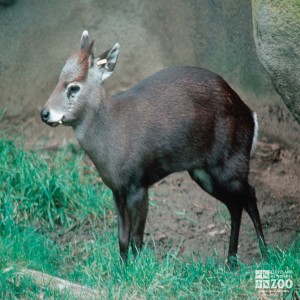Tufted Deer
[Elaphodus cephalophus]

The tufted deer has a head and body length of 43 to 62 inches, a tail length of 3 to 6 inches, shoulder height of 19.5 to 27.5 inches, and weight of 37 to 110 pounds. They have small unbranched antlers approximately 1 inch long which are often completely hidden by tufts of hair growing from the forehead. The coarse, shaggy coat is a deep chocolate brown with a gray neck and head, the forehead tuft being blackish brown. The underparts, tips of ears, and the underside of the tail are white. They have upper canines which in the males become 1-inch tusks. The young are similar to the adults but have a row of spots along each side of the back. Median age range is 7 years.
Location: Tufted Deer Yard (Historical Location)
Share:
Range
The range of the tufted deer is south, southeast and central China, northeast Burma.
Habitat
The tufted deer inhabits mountainous forests up to 15,000 ft., usually near water.
Conservation Status
Near ThreatenedPrimary Threats
Human Wildlife Coexistence. Habitat Loss.Gestation
Gestation for tufted deer takes 180 days.
Litter
1-2 young. Born early summer.
Behavior
Tufted deer are usually solitary, but occasionally they travel in pairs. They use a "bark" to communicate with each other, especially during courtship and when alarmed. When feeding they carry their tails high, while moving or standing still they "flop" showing the white underside with every bounce. Antorbital glands are used for marking territory. Grooming is apparently very important, and they will groom themselves frequently. All grooming is seen in captivity between females, rarely between males.
Reproduction
Courtship rituals for tufted deer are not well described. Mating occurs September through December with 1-2 fawns being born in late spring and early summer.
Wild Diet
Grasses and other vegetation.
